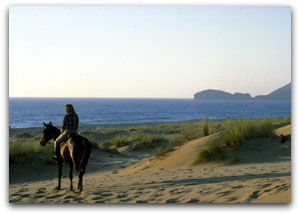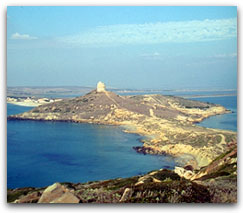Going northward along the coast
one reaches the long and beautiful beach of Portixeddu which ends at Capo Pecora. Behind
this beach there are huge sand dunes with rich vegetation that prevents the sand from being
blown away by the strong western winds.
|
The coast that comes before Capo Pecora
belongs to the comune of Fluminimaggiore in the vicinity of which there are the caves of "Su Mannau",
that are open to visitors for most of their length, and the temple of Antas dedicated to "Sardus Pater" who
was an ancient local god. Travelling further on there is "Costa Verde" and Marina di Arbus, that are preceded
by the spectacular sand "colata" (sand flows) of Ingurtosu whose dunes with thick junipers slope down to the
sea in large almost deserted spaces where fortunately man has not yet managed to pollute or build.
|
|

 Marina di Arbus Marina di Arbus |

 Ingurtosu - industrial archaeology Ingurtosu - industrial archaeology |
|
Ingurtosu is a mining village,
nowadays virtually abandoned, where the full splendour of the old mining period can be still
seen.
A word of warning, the temptation to dive into the sea at this point can be very strong but be
very careful (especially if you are not good swimmer) because the sea bed is very steep and
the water becomes very deep close to the beach and the long "oceanic" waves can be
dangerous.
|
Another military area is the area
of Capo Frasca, which like Teulada, is off bounds to unauthorised vessels. After Capo Frasca
one enters the wide and sheltered Gulf of Oristano. In
this Gulf there are many important places. Among which there is
Oristano, the capital of this province and Arborea and Cabras
where the most important Sardinian wetlands are situated. These designated wetlands are
protected by international law and are home to many different species of birds and
fish.
|
To the north the peninsula of
Sinis marks both the end of this part of our tour and the end of the Gulf of Oristano. This area
is important not only for the beauty of the coast but principally for the Punic-Roman town of
Tharros, which is situated behind Capo San Marco, whose archaeological excavations have
brought to light not only monuments of those civilisations but also numerous precious
artefacts that can be admired in museums in London, Oristano and
Cagliari.
|
|

 The peninsula of Sinis The peninsula of Sinis |
|